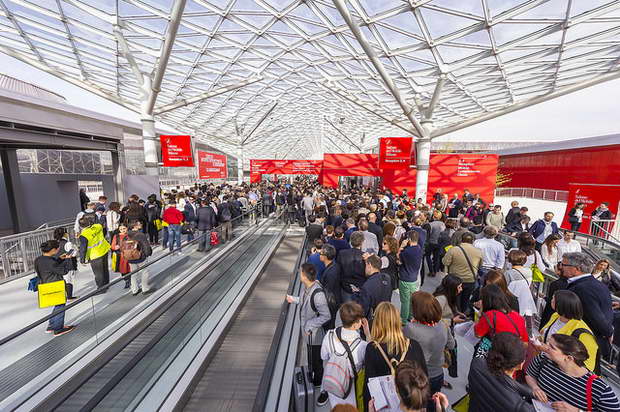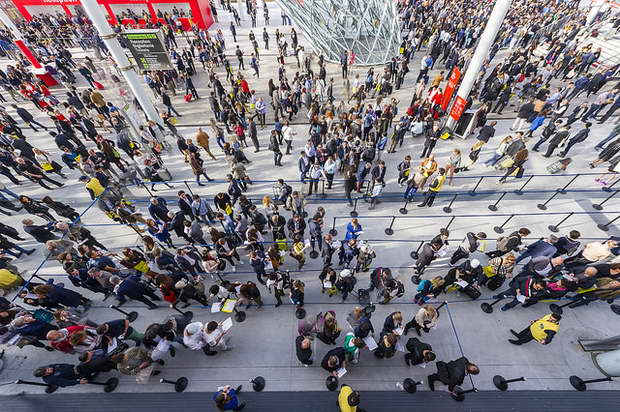The Salone del Mobile 2015 is the apogee of design. Not only is the Milan event the greatest trade fair in the world, it is also the true litmus test for progressive design trends. Here is a brief round-up of the prevailing trends.
STORY TELLER is the buzzword for the 2015 edition. Telling stories, creating atmospheres, forming references, working quotes: these are the signals being sent by design – once an isolated technistic discipline, it has now become an increasingly large part of much bigger and indissoluble magma, created through lifestyle and personal experience. TELLING STORIES is therefore the real theme of 2015 and, possibly, stories about BEAUTY. Indefinable – naturally, different for each one of us – naturally, yet it is clear that the leading designers this year have fought for “their own” idea of beauty. Sometimes negotiating aesthetically impervious ground, where none has dared tread before, as evidenced by Konstantin Grcic, “ground breaker” par excellence, with his “Sam Son” easy armchair for Magis.

While seeking inspiration for their stories, designers are increasingly won over by charm: artists, people and, especially, places. This last trend is particularly evident at the 2015 Salone. This year’s destinations: Miami (signalling the unforeseeable resurgence of ’80s taste), Northern Europe (minimalism in pastel colours) and especially Africa, both Mediterranean Africa and Black Africa (in this case, travel meets ETHNIC).
Let’s focus on this last “destination” first. Inspiration can be immediate, as it was for Sebastian Bergne and his “Shorty” stool/container Sebastian Bergne or TOG, or for Jaime Hayon and Cassina, mediated by the first wave of African Cassina influence in Europe: the Spanish designer deduces strange wooden idols in Le Corbusier’s work: “almost a religious challenge”, according to Hayon. LucidiPevere, the Italian duo, look “far away”, to the remote Mongolian mountains, for their new “Yak” sofa for De Padova. China is referenced in Raffaella Mangiarotti and Marco Ravina’s “Honey” lantern for Serralunga. Meanwhile Driade is “putting out roots” with the young Italia Giorgio Bonaguro’s transparent Pyrex “Root” vase, containing a colourful glass tuber.
Ethnic rapidly gives way to LOCAL. The local dimension is where hopes of conquering a global market are vested these days. While in the ’50s, manufacturers strove to achieve internationally recognised beauty, these days the idioms and the dialects make up the new Esperanto. One such new vocabulary is exemplified in Ronan & Erwan Bouroullec’s Franco-Finnish composite collection “Kaari” for Artek,in which solid wood is supported by bent metal, combining the carpenter’s simplicity with a clear reference to the “Swedish” furniture of the ’70s.
Food design is undoubtedly what sparked this phenomenon, making local – and local craftsmanship in particular – a crucial element. Thus ARTISANAL WORKMANSHIP (declined in an industrial key, naturally) has become one of the most powerful driving trends. Alessi, for example, has used craftsmen from the Strona Valley to carve designs by Marcel Wanders onto its beechwood platters and plates.
This recent shift towards the local dimension appears to have overtaken the NORDIC MINIMALISM that dominated last year. There are stil very clear signs of it, in the pavilions, of course. The most interesting pieces are those in which form is not simply the end product, but stimulus for exploration, typological for example, as in the designer duo Kaschkasch’s “Fju” desk for Living Divani, which flips up to become a wallmounted document storage system. Lorenzo Damiani’s “Bed Sharing” “wall art” for Campeggi, made up of individual mattresses that can be pulled out and used when needed, is another such example. The pieces in which minimal meets GREAT HISTORICAL TRADITION head on are equally interesting: see Christian Werner’s “2002” sofa for Thonet, in which the solid bentwood bracket wraps round a padded bed base more or less resting on the floor.

At the other end of the scale, MIAMI was one of the trendy geographical destinations mentioned earlier. In 2015 Miami, or the concept or it, became the top tip of a triangle with Moscow and Dubai on the others. A taste for th A taste for the lavish and embellished sprang up across the world, maximalist but not necessarily kitsch. Evidence of this can be seen in Fiam’s “Ginevra” mirror, designed by Dante O. Benini and Luca Gonzo with the Albanian artist Helidon Xhixha, in Gallotti&Radice’s “Oto” round table by Gabriele and Oscar Buratti, in bronze, copper or gunmetal, and Flou’s new “Iko” bed by Rodolfo Dordoni.
This world of journeys, of references (and emotions) naturally calls for its own colour palette. So, while the colour of 2015, according to Pantone, is Marsala (actually a reddish brown), there is no shortage of other fairly particular shades. Deliberately impure colours, rich in oxides and pigments: teal, blueberry and barley are the colours selected by Sam Baron for his “… Issima!” collection of vases for Bosa. SHADED colours are bang on trend: Ron Arad’s “Glider” sofa for Morosoranges from red to violet, for example.
DESCRIPTIVE could well make another interesting trend for 2015. In other words, “a vase is a vase”, but also “a chair is a chair”. Tautological definitions, certainly, but in the current uncertain times, they take on a reassuring psychological connotation. The famous British architect David Chipperfield has chosen to go down this road in his partnership with German brand e15, producing an absolutely essential table (“Fayland”), bench (“Fawley”) and stool (“Langley”) in solid oak. Equally, Tokujin Yoshioka’s “Prism” design for Glas Italia could be described as “cabinet-cabinet”: two square metres of air enclosed in see-through crystal, not to mention Jean-Marie Massaud’s “Santa Monica Home” “bérgère-bérgère” armchair for Poliform, seemingly made entirely of fabric.
In tandem, slightly under the radar yet clearly one of the emerging trends for 2015, is the CHILDREN’S WORLD (as a figurative reference at least, if not a product category in its own right). See “Wooden Dolls Cat und Dog”, assembled and dismantled with magnets, designed by Alexander Girard in 1952 and now reproposed by Vitra, and Arik Levy’s “Concentric Puzzle” for Danese, reprising Enzo Mari’s educational toys. Bosa’s idealised a animals also cast a spell: Sam Baron’s unicorn, Jaime Hayon’s duckelephant, Ionna Vautrin’s exotic toucan and Lanzavecchia+Wai’s crafty wolf.
Lastly there is Martino Gamper, the joker in the Italian design pack, who appears to throw his rings, in curved wood, to score a direct hit on Gebrüder Thonet Vienna’s “Cirque” stool.
In their search for myths, our contemporary “storyteller-designers” could not but strive for the pinnacle of the GREAT DESIGNERS OF YESTERYEAR. Many eyes have focused on Charlotte Perriand, a woman, beautiful, brave and genuinely ahead of her time. Cassina has recently re-edited some splendid pieces, including a technological project – the collection of sound-absorbing “President” panels, designed by Philippe Nigro for Caimi Brevetti, figuratively drawn from the great French heroine.
The “Schegge” table, designed by ivdesign.it for Valsecchi 1918 references one of the great outsiders of Italian design, Carlo Mollino, with polished irony. One of the few pieces of furniture by the great Nordic designer Tapio Wirkkala (born in 1915, no less), Poltrona Frau’s 1952 low “Bird” table, makes a comeback. Of Frau all the forgotten heroes, or rather the forgotten heroines (one of 2015’s trends is undoubtedly WOMEN DESIGNERS) this Salone seems to be specifically dedicated to Nanda Vigo, the unconventional fellow traveller of the leading artists of the ’60s-’70s, from Fontana to Manzoni. A few of her pieces, such as Driade’s 1971 “Blocco” pouffe, are making a re-appearance, as is her huge legacy.
It might seem only right and proper to end this review of distinguishing Salone del Mobile 2015 trends with a reference to Expo 2015, which opens ten days after the end of the Salone, and its theme, “Feeding the Planet, Energy for Life.” It seems more pertinent, however, to consider Okwui Enwezor’s theme, “All the World’s Futures”, for the 2015 Venice Biennale, which is basically the underlying theme of the Salone del Mobile in Milan. An event capable of telling every possible story about the future of design in the world.
Photos courtesy Salone del Mobile. Milano
Photo credits:
AM Andrea Mariani
AR Alessandro Russotti
CM Carola Merello
SLV Saverio Lombardi Vallauri
